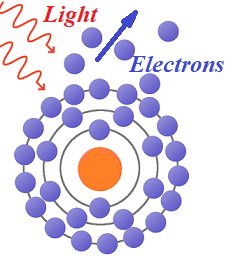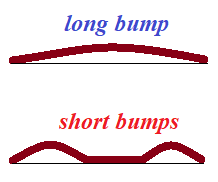Photoelectricity
In the previous lecture "Energy of Light" of this chapter we investigated the amount of energy carried by electromagnetic waves.
A single wavelength λ of harmonic oscillations of electromagnetic field carried an energy
Wλ = (λ/4)·[ε0·E0²+(1/μ0)·B0²]
where
ε0 is the electric permittivity of vacuum,
E0 is an amplitude of electric component of the field oscillations,
μ0 is the magnetic permeability of vacuum,
B0 is an amplitude of magnetic component of the field oscillations.
We can shorten this formula using a dependency between electric and magnetic amplitudes E0=c·B0 and expression of the speed of wave propagation c in terms of permittivity and permeability of vacuum c²==1/(ε0·μ0) described in the previous lecture.
Wλ =
= (λ/4)·[ε0·E0²+(ε0/c²)·B0²] =
= (λ/4)·[ε0·E0²+ε0·E0²] =
= (λ/2)·ε0·E0² =
= (c·τ/2)·ε0·E0²
where τ is a period of oscillations, that is the time a wave propagates by the distance equal to its wave length.
As you see, it's proportional to a wave length and to a square of amplitude of oscillations.
When these electromagnetic waves (like visible light) fall on some surface, some of this energy is absorbed by the material it falls on. Obvious consequence of this is that this energy is converted into heat, and the temperature of the surface should rise.
While this is, generally, true, some experiments showed that not only the temperature of the surface is increasing, but some electrons are flying off that surface and can be detected.
This was discovered by Heinrich Hertz, a German physicist, in 1887 and is known as Hertz effect or photoelectric effect or photoemission and these flowing away electrons were called photoelectrons.
.

With proper arrangement these electrons, kicked out from their orbits around an atom's nucleus by falling waves of electromagnetic oscillation, can form an electric current and used to detect some events related to light.
A simple example of this arrangement can have a negative pole of a battery connected to a metal surface A, while a battery's positive pole connected to some other metal plate B positioned opposite to A on a small distance. If a light that causes photoelectric emission falls on a surface A, it kicks off some electrons, which will be immediately attracted to surface B, thus creating a current in a circuit, while the light is on. This can, for example, be used to count parts on a conveyer going across some light beam with the beam interrupted with each part passing by.
Numerous experiments were conducted to research this process.
Different materials were used (primarily, metals), different intensities and frequencies of light were experimented with and very important observations were made.
The fact that the beam of light kicks off some electrons from a surface of a metal was not surprising.
Expected results of experiments were that the brighter light (higher amplitude of electromagnetic oscillations) should cause electrons to be flying off a surface in larger quantities and higher speed and, therefore, higher kinetic energy. Also, even the low intensity beam of light should gradually supply sufficient amount of energy for electrons to start flying off a surface of a metal.
What was surprising was that experiments did not produce these expected results.
Most importantly, for any kind of metal there was a specific frequency of electromagnetic waves (ω - angular frequency, f - regular frequency, that is the number of oscillations per second and ω=2π·f) or, equivalently, specific wave length (λ=2π·c/ω=c/f, where c is a speed of light) such that with this and higher frequency (or, equivalently, this and shorter wave length) the photoelectric effect was observed, but lower frequencies of waves (or longer wave lengths) did not cause this effect, no matter how long or how bright the light was shining on a metal surface, so the low frequency light energy was converted into internal heat with no photoelectrons emitted.
Without pretending that the following is a true explanation of why a specific frequency (or higher) is needed to kick off photoelectrons from a surface of a particular metal plate, we consider the following analogy helpful to intuitively feel the underlying mechanism of photoemission.
Consider you are in a car riding on a bumpy road. Assume, all bumps are of the same height, but different length, some short and steep, some long and gradually changing the height.

A car can go over a long bump, when it slowly rising to its maximum height and slowly going down or it can be a short bump of the same height, but the car will have a steeper rise to its peak and steeper way down.
If you ride inside a car on this bumpy road, you will, probably, feel almost nothing going over a long bump, but a short one will cause a jerk and you will be thrown up by a couple of inches.
Steep forceful rise of a car causes it to sharply accelerate upwards, and whoever is inside will feel a strong but short lived force pushing upwards and, maybe, even exceeding the force of gravity.
Similar thing happens when after washing your hands you try to get rid of excess of water by shaking it off. Slow movement of hands with any amplitude will not do a trick because the acceleration of the water drops would be insufficient to shake these drops off, but short and abrupt motion will be effective, the drops will fall off.
Well, similar thing happens with electrons. A long electromagnetic wave length (that is, a wave of a low frequency) rises the energy of electrons inside a metal slowly and the energy dissipates among other electrons, not actually rising in any particular electron high enough to tear it off a nucleus against a force of a nucleus attraction.
If, on the other hand, a short wave hits an electron, it acts like a short bump to a car, it quickly lifts it, kicking off an orbit, so it becomes a free photoelectron.
So, for light to cause the photoelectric effect it's necessary to have to abruptly "shake" an electron with a short wave length (that is, high frequency) of light.
Albert Einstein has received a Nobel Prize in Physics for a really scientific theory of photoelectric effect based on a concept of light energy carried by discrete packets called light quanta or photons.
This and works of other physicists, like Max Planck, was the beginning of quantum theory, one of the major developments of the 20th century Physics.
It also showed a duality of electromagnetic waves that in some circumstances act like waves, while in other cases demonstrate quantum properties similar to particle theory of the past.
The wave theory of electromagnetic field developed by Maxwell and reflected in Maxwell's equations (see the chapter "Electromagnetic Field Waves" in this part "Waves" of a course) considers electromagnetic field as the space with continuous distribution of energy.
Einstein's approach was to consider the light (and electromagnetic field in general) as a space with discrete distribution of energy, with each "particle" of light carrying certain finite amount of energy - a photon.
According to this theory, each light quantum (or photon) carries an energy Ephoton that is proportional to its frequency
Ephoton = h·f
where
h=6.63·10−34 J·s (Joules·seconds) is Planck's constant and
f is the wave frequency, units of which are 1/s (Hertz, oscillations per second).
Each electron is attracted to some nucleus. It means, it needs some energy Efree to fly free, same as a spaceship needs an energy to break off the Earth gravitation.
An electron can absorb only one photon and either is kicked off its orbit, if the frequency of incident radiation is sufficiently high, or stays near its nucleus, if the frequency of radiation is not high enough.
If a photon hits an electron and the photon's energy Ephoton exceeds than what's needed to set free an electron Efree, the electron becomes a free photoelectron and, for example, can be used in some electronic device.
Excess energy Ephoton−Efree is transformed into kinetic energy of a photoelectron, which results in a simple equation
Ephoton−Efree = ½me·V²
or
Ephoton = Efree + ½me·V²
where
me is a mass of an electron,
V is the speed of an electron kicked off its orbit by a photon.
The concept of a photon leads to a new understanding of a term intensity, as applicable to light and other electromagnetic radiation. Intensity of radiation is defined as a quantitative characteristic of radiation proportional to the number of photons produced per unit of time.
At the same time the number of photoelectrons emitted from a surface per unit of time as a result of an incident radiation with sufficiently high frequency is also proportional to a number of photons falling on this surface.
Therefore, the photoelectric current, that is proportional to a number of photoelectrons produced in a unit of time, is proportional to intensity of incident radiation.


No comments:
Post a Comment